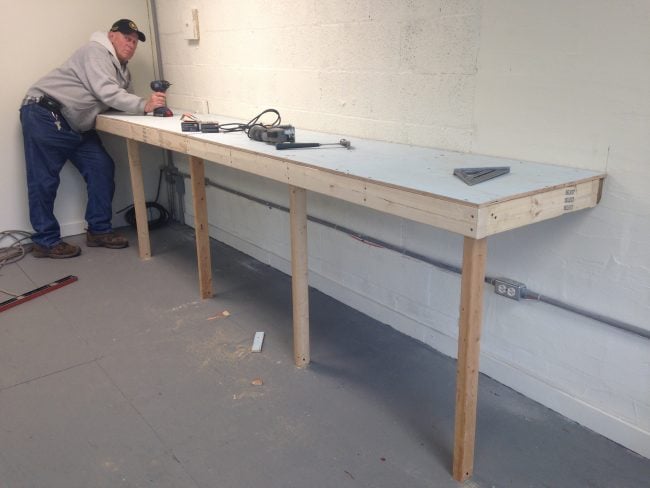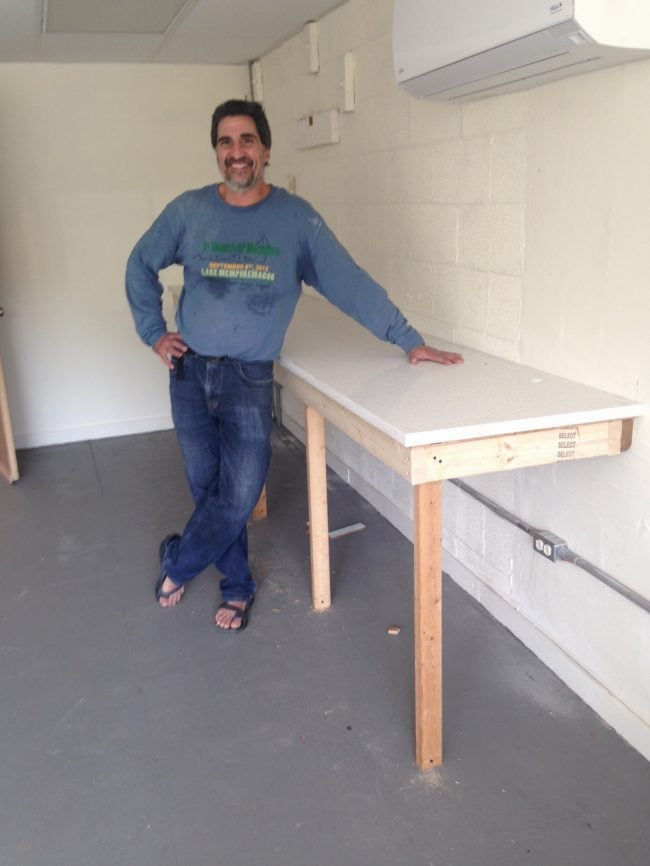Who builds the lab for community science? The community, of course

Ron Searl, a master carpenter and volunteer for the Hudson River Maritime Museum, shows his handiwork at the new Riverkeeper lab in Kingston. (Photo by junior carpenter Dan Shapley / Riverkeeper)
View more images on our Flickr site
Creating and outfitting Riverkeeper’s new lab and office space at the Hudson River Port has been a community effort, which is appropriate, since one of its primary purposes is to support community science. Next week, individuals will lift samples from the Rondout, Esopus and Catskill creeks, and the Wallkill River, and deliver them to Kingston for processing.
The Hudson River Maritime Museum‘s staff and volunteers spent countless hours converting a storage loft in the museum’s East Gallery into an office space, with HVAC and beautiful windows overlooking the Rondout Creek and a spiral staircase among the most noteworthy improvements.
The Hudson River Foundation, through the Hudson River Improvement Fund, and IDEXX, the manufacturer of the lab equipment that has democratized sampling for bacterial contamination, made donations that made outfitting the laboratory possible. U.S. Geological Survey is loaning an extra incubator to assist with the processing of samples that will support a pollution source-trackdown effort in the Rondout Creek and Wallkill River, a project funded by the NYS Environmental Protection Fund, via a grant from the Hudson River Estuary Program. The Estuary Program is also supporting our efforts to expand community science projects on the Wallkill River, in partnership with the Wallkill River Watershed Alliance.

Ron Searl, a master carpenter and volunteer for the Hudson River Maritime Museum, shows his handiwork at the new Riverkeeper lab in Kingston. (Photo by junior carpenter Dan Shapley / Riverkeeper)
Then, there’s the lab counter, created through volunteer effort by Ron Searl, who built and installed the frame, and David Barra and Martin Trumbore, who donated and installed the stone countertop.

David Barra, of Barra & Trumbore, in Riverkeeper’s Hudson River Port lab and office. (Photo by Dan Shapley / Riverkeeper)
Check out Ron’s other work in the Hudson River Maritime Museum, where he has built many of the exhibits, including a tugboat simulator that you can pilot, a scale model of the Rondout Lighthouse and more. And check out Barra & Trumbore if you’re in the market for a kitchen or bathroom project. Judging by the way they lifted heavy stone up a spiral staircase, no job is too tall, or twisty.
When Dave isn’t installing beautiful stone counters, he and his organization, New York Open Water, are organizing the 2 Bridges Swim Under the Walkway and the 8 Bridges Swim, the longest open water swim event in the world – right here in the Hudson River. The 2 Bridges Swim is June 4 in Poughkeepsie, and the first leg of the 8 Bridges Swim is June 26, from the Rip Van Winkle Bridge to the Kingston-Rhinecliff Bridge.
Capt. John Lipscomb will continue to sample the Hudson River Estuary in partnership with Lamont-Doherty Earth Observatory and CUNY Queens College, as they have at 74 locations monthly since 2008. But opening the lab in Kingston, and partnering with the Center for the Urban River at Beczak, the Bard Water Lab, SUNY Cobleskill, The River Center, Ossining High School and a number of other organizations, allows us to both expand the community science projects he started AND give Capt. Lipscomb the equivalent of a full month of time each season for other patrol work to investigate and stop pollution.
